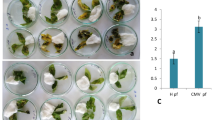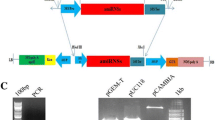Abstract
Sugarcane streak mosaic virus (SCSMV) belonging to Poacevirus, is a causative virus of mosaic disease in sugarcane in many Asian countries with substantial genomic variation. Although the virus infects the crop with Sugarcane mosaic virus (SCMV) a Potyvirus, it predominates over SCMV in spread as well as titre. We have taken up detailed studies to identify the functional activity of viral suppressors of SCSMV genome. Transient expression assay was performed with SCSMV-P1 and HC-Pro genes in the model plant Nicotiana tabacum to establish suppressor role of these genes. The plasmid constructs of both the genes were co-infiltrated with the reporter green fluorescent protein (GFP) and the suppressor activity was measured as enhancement in the GFP fluorescence. Further, the phenotypic expressions were validated by respective gene expression through semi quantitative and qRT-PCR. In the P1 co-infiltrated GFP leaves, suppression in the PTGS mechanism took place that allowed a long term expression of GFP. However, GFP co-infiltrated with HC-Pro did not sustain the GFP expression level for a prolonged period and the expression level was close to GFP control. The study concluded that unlike in other Potyviridae genera, P1 gene of SCSMV is playing the role of RNA silencing suppressor. This study helps in unveiling a new and promising way to understand the regulatory pathway in the host at the time of viral infection. Targeting the P1 gene of SCSMV through RNA silencing approach will be a viable strategy to develop mosaic resistant transgenic sugarcane varieties as they are directly involved in counter defence against the host.



Similar content being viewed by others
References
Azevedo J, Garcia D, Pontier D, Ohnesorge S, Yu A, Garcia S, Braun L, Bergdoll M, Hakimi MA, Lagrange T, Voinnet O. Argonaute quenching and global changes in Dicer homeostasis caused by a pathogen encoded GW repeat protein. Genes Dev. 2010;24:904–15.
Bagyalakshmi K, Parameswari B, Chinnaraja C, Karuppaiah R, Ganesh Kumar V. Genetic variability and potential recombination events in the HC-Pro gene of Sugarcane streak mosaic virus. Arch Virol. 2012;157:1371–5.
Bagyalakshmi K, Parameswari B, Viswanathan R. Phylogenetic analysis and signature of recombination hotspots in Sugarcane mosaic virus infecting sugarcane in India. Phytoparasitica. 2019;47:275–91.
Bohmert K, Camus I, Bellini C, Bouchez D, Caboche M, Benning C. AGO1 defines a novel locus of Arabidopsis controlling leaf development. EMBO J. 1998;17:170–80.
Chalfi M, Tu Y, Euskirchen G, Ward WW, Prasher DC. Green fluorescent protein as a marker for gene expression. Science. 1994;263:802–5.
Csorba T, Pantaleo V, Burgyan J. RNA silencing: an antiviral mechanism. Adv Vir Res. 2009;75:35–71.
Ding SW, Voinnet O. Antiviral immunity directed by small RNAs. Cell. 2007;130:413–26.
Dunoyer P, Lecellier CH, Parizotto EA, Himber C, Voinnet O. Probing the microRNA and small interfering RNA pathways with virus-encoded suppressors of RNA silencing. Plant Cell. 2006;16:1235–50.
Fischer R, Vaqueron MC, Sack M, Drossard J, Emans N, Commandeur U. Towards molecular farming in the future: transient protein expression in plants. Biotechnol Appl Bioc. 1999;30:113–6.
Fukunaga R, Doudna JA. dsRNA with 5′ overhangs contributes to endogenous and antiviral RNA silencing pathways in plants. EMBO J. 2009;28:545–55.
Giner A, Lakatos L, Garcia CM, Lopez MJJ, Burgyan J. Viral protein inhibits RISC activity by argonaute binding through conserved WG/GW motifs. PLoS Pathog. 2010;6:e1000996.
Glick E, Zrachya A, Levy Y, Mett A, Gidoni D, Belausov E, Citovsky V, Gafni Y. Interaction with host SGS3 is required for suppression of RNA silencing by Tomato yellow leaf curl virusV2 protein. PNAS USA. 2008;105:57–161.
Kasschau KD, Cronin S, Carrington JC. Genome Amplification and long-distance movement functions associated with the central domain of tobacco etch Potyvirus helper component-proteinase. Virology. 1997;228:251–62.
Kasschau KD, Fahlgren N, Chapman EJ, Sullivan CM, Cumbie JS, Givan SA, Carrington JC. Genome-wide profiling and analysis of Arabidopsis siRNAs. PLoS Biol. 2007;5:e57.
Kasschau KD, Xie Z, Allen E, Llave C, Chapman EJ, Krizan KA, Carrington JC. P1/HC-Pro, a viral suppressor of RNA silencing, interferes with Arabidopsis development and miRNA unction. Dev Cell. 2003;4:205–17.
Lakatos L, Csorba T, Pantaleo V, Chapman EJ, Carrington JC, Liu YP, Dolja VV, Calvino LF, Lopez-Moya JJ, Burgyan J. Small RNA binding is a common strategy to suppress RNA silencing by several viral suppressors. EMBO J. 2006;25:2768–80.
Lindbo JA, Silva RL, Proebsting WM, Dougherty WG. Induction of a highly specific antiviral state in transgenic plants: implications for regulation of gene expression and virus resistance. Plant Cell. 1993;5:1749–59.
Livak KJ, Schmittgen TD. Analysis of relative gene expression data using real-time quantitative PCR and the \({2 ^{-\Delta \Delta {C_{\text T}}}}\) Method. Methods. 2001;25:402–8.
Ma PD, Lu TC, Zhou XF, Zhu XJ, Wang XZ. Preparation of polyclonal antibodies of rubisco large and small subunits and their application in the functional analysis of the genes. Acta Biochim Biophys Sin. 2004;36:644–8.
Merai Z, Kerenyi Z, Kertesz S, Magna M, Lakatos L, Silhavy D. Double-stranded RNA binding may be a general plant RNA viral strategy to suppress RNA silencing. J Virol. 2006;80:5747–56.
Parameswari B, Bagyalakshmi K, Chinnaraja C, Viswanathan R. Molecular characterization of Indian Sugarcane streak mosaic virus isolates reveals recombination and negative selection in the P1 gene. Gene. 2013;552:199–203.
Silhavy D, Burgyan J. Effects and side-effects of viral RNA silencing suppressors on short RNAs. Trends Plant Sci. 2004;9:76–83.
Silhavy D, Molnar A, Lucioli A, Szittya G, Hornyik C, Tavazza M, Burgyan J. A viral protein suppresses RNA silencing and binds silencing-generated, 21- to 25-nucleotide double-stranded RNAs. EMBO J. 2002;21:3070–80.
Tatineni S, Qu F, Li R, Morris TJ, French R. Triticum mosaic poacevirus enlists P1 rather than HC-Pro to suppress RNA silencing mediated host defense. Virology. 2012;433:104–15.
Tatineni S, Ziems AD, Wegulo SN, French R. Triticum mosaic virus: a distinct member of the family Potyviridae with an unusually long leader sequence. Phytopathology. 2009;99:943–50.
Viswanathan R. Varietal degeneration in sugarcane and its management in India. Sugar Tech. 2016;18:1–7.
Viswanathan R, Balamuralikrishnan M, Karuppaiah R. Characterization and genetic diversity of Sugarcane streak mosaic virus causing mosaic in sugarcane. Virus Genes. 2008;36:553–64.
Voinnet O, Lederer C, Baulcombe DC. A viral movement protein prevents spread of the gene silencing signal in Nicotiana benthamiana. Cell. 2000;103:157–67.
Wesley SV, Helliwell CA, Smith NA, Wang MB, Rouse DT, Liu Q, Gooding PS, Singh SP, Abbott D, Stoutjesdijk PA, Robinson SP, Gleave AP, Green AG, Waterhouse PM. Construct design for efficient, effective and high-throughput gene silencing in plants. Plant J. 2001;27:581–90.
Wroblewski T, Tomczak A, Michelmore R. Optimization of Agrobacterium-mediated transient assays of gene expression in lettuce, tomato and Arabidopsis. Plant Biotechnol J. 2005;3:259–73.
Acknowledgements
The financial support received from the Department of Biotechnology, New Delhi (BTPR4978-AGR-36712-2012) is greatly acknowledged.
Author information
Authors and Affiliations
Corresponding author
Ethics declarations
Conflict of interest
The authors declared that there is no conflict of interest.
Additional information
Publisher's Note
Springer Nature remains neutral with regard to jurisdictional claims in published maps and institutional affiliations.
Electronic supplementary material
Below is the link to the electronic supplementary material.
Rights and permissions
About this article
Cite this article
Bagyalakshmi, K., Viswanathan, R. Identification of the RNA silencing suppressor activity of sugarcane streak mosaic virus P1 gene. VirusDis. 31, 333–340 (2020). https://doi.org/10.1007/s13337-020-00618-7
Received:
Accepted:
Published:
Issue Date:
DOI: https://doi.org/10.1007/s13337-020-00618-7




